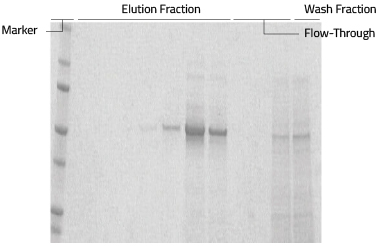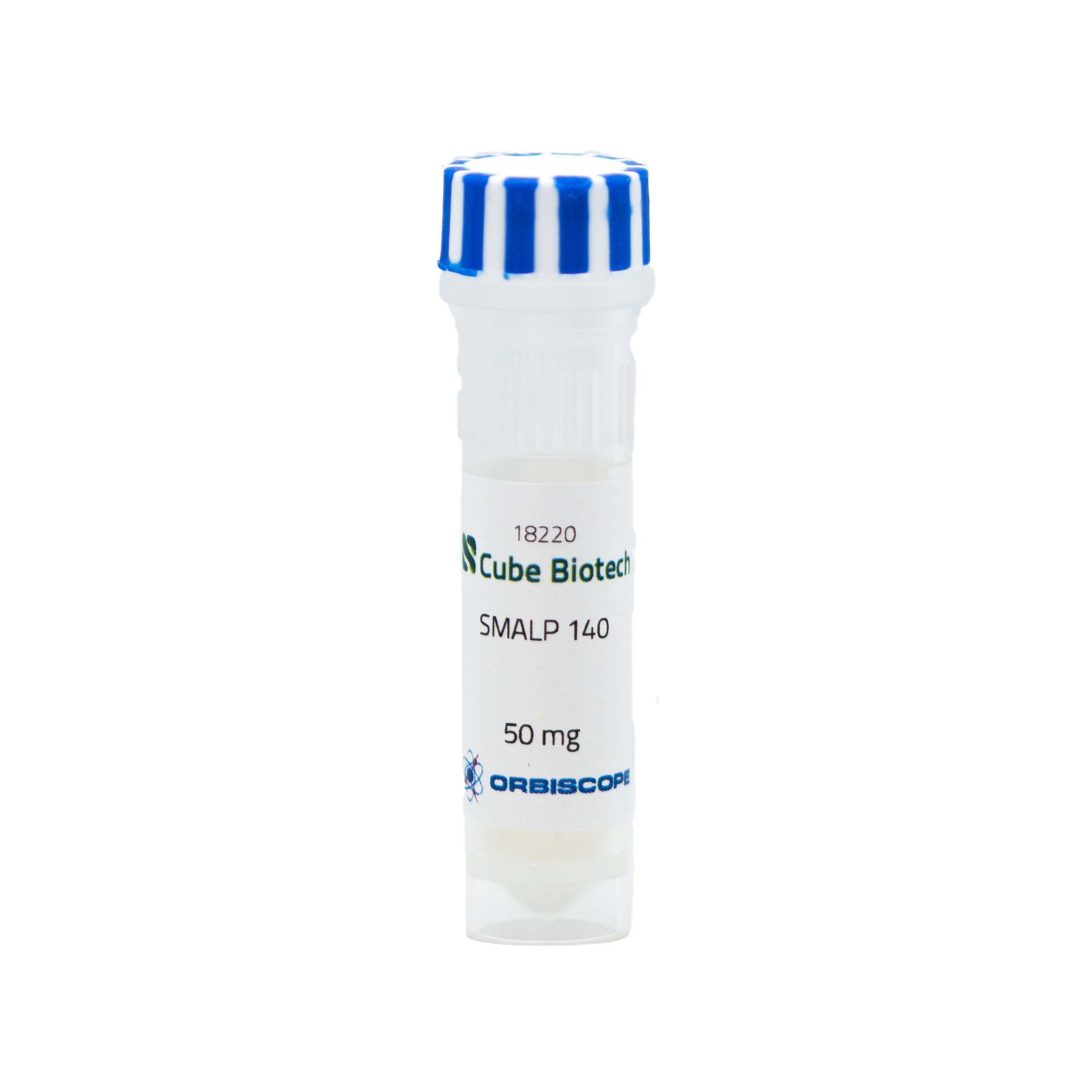SMALP 140
Order number: 18222
Description
The synthethic polymer SMALP 140, among our other synthetic nanodisc products has been developed for for the solubilization & subsequent purification of membrane proteins from all kinds of cell membranes. SMALP products do this by using the phospholipids around the membrane proteins and form them into a disc-shaped structure in which the membrane proteins are centered.
SMALP 140 + its corresponding buffer are shipped in a lyophilized state, so they have to be dissolved in dH2O. Then the product is ready-to-use. SMALP 140 has a amber color in solution.
We recommend using affinity chromatography for the follow-up purification of the membrane protein of interest. For membrane protein purification we recommed to use the Rho1D4-tag. Cube Biotech offers the matching products for this purpose.
| Feature | |
|---|---|
| State | Lyophilized Powder, to be solved with water |
| Polymer styrene-to-maleic anhydride ratio | 1.4:1 |
| Molecular weight | 5,000 Da |
| pH after solving | 7.5 |
| Solubility | 45 % |
| Divalent cationic tolerance | < 5 mM |
| Color | Amber |
| Odor | Odorless |
| Freeze-thaw stable? | Yes |
| Shipping Temperature | ambient temperature |
| Storage of lyophilized copolymer | -20°C for several years |
| Storage of dissolved copolymer | 2-8°C for several days |
| Structure |  |
Citations
| Stabilized protein | Year | Author |
|---|---|---|
| Bacterial Membrane Proteins | 2022 | Noh I., Guo Z., Zhou J., Gao W., Fang R.H., Zhang L. |
| ATP-binding cassette (ABC) transporter | 2023 | Dimitrova V.A., Song S., Karagiaridi A., Marand A., Pinkett H.W. |
| Env-protein of HIV | 2023 | Zhou R., Zhang S., Nguyen H.T., Ding H., Gaffney A., Kappes J.C., Smith III. A.B.S, Sodroski J.G. |
Lab Results
SMALP Screening: Different membrane protein usually perform different under different SMAs variants respectively. To ease the resulting screening process we compiled all of our SMAs into a convenient SMALP Screening Set.
Furthermore if you like to compare proteins's performance between SMA and DIBMA in synthetic nanodiscs, we also offer our, that includes both our SMA and DIBMA products.

Video
Watch our video on the use of synthetic polymers for membrane protein solubilization. It demonstrates the use with SMALP.
FAQ
What SMA is the best one to use?
This is a tricky question, as it depends on the membrane protein which SMA performs best, however, SMA 200 is in general the most recommended. Keep in mind that this is no guarantee for it to be the best but in our experience, it is a good allrounder.
What are the recommended concentrations of SMA?
Mix the supplied solutions at a concentration of 1-5% SMALP to the total solution. These conditions can be used as indications. The optimal SMA concentration must be determined separately for each experiment.
How is SMA stored?
Store in cool and dry places, protected from direct sunlight. Long-term storage is recommended at 4°C
The viscosity of my SMA has decreased, what happene
This can occur by storing SMA at low temperatures (as recommended!). Simply warm the SMA solution up to room temperature to restore its original viscosity.
How do I quantify the amount of protein after SMA treatment?
In contrast to DIBMA, SMA absorbs light at 280 nm similar to proteins. Therefore ultraviolet absorption is no option here. However other protein quantification assays are viable options like:
- Bicinchoninic Acid (BCA)
- Bradford
- Folin-Lowry in some cases
Disclaimer
The use of this styrene maleic acid copolymer (SMA) product for the manufacture of styrene maleic acid copolymer - lipid particles (SMALP), and the use of SMALP, are covered by one or more of the following patents owned by Malvern Cosmeceutics Limited: US 8623414, EP 1890675, GB 2426703, AU 2006253886, JP 5142898, IN 261468, CN ZL200680018957.2 and CA 2,611,144 and by the University of Birmingham: US 8754168.
The purchaser is licensed under those patents to use the SMA for the manufacture of SMALP and to use the SMALP for the purpose of research and development of proteins, including their production (including purification and solubilisation), screening testing, analysis, characterisation (including structural analysis and characterisation), including for the purpose of drug screening and for the purpose of in vitro diagnostics, but not for the purpose of delivery of agents to humans or other animals for therapeutic, diagnostic (including in vivo diagnostics) or prophylactic purposes, which uses are specifically prohibited.
The use of SMALP 502-E within the United States is not covered by our current license and this product can therefore not be made available for US purchasers.
The purchaser is licensed under those patents to use the SMA for the manufacture of SMALP and to use the SMALP for the purpose of research and development of proteins, including their production (including purification and solubilisation), screening testing, analysis, characterisation (including structural analysis and characterisation), including for the purpose of drug screening and for the purpose of in vitro diagnostics, but not for the purpose of delivery of agents to humans or other animals for therapeutic, diagnostic (including in vivo diagnostics) or prophylactic purposes, which uses are specifically prohibited.
The use of SMALP 502-E within the United States is not covered by our current license and this product can therefore not be made available for US purchasers.



